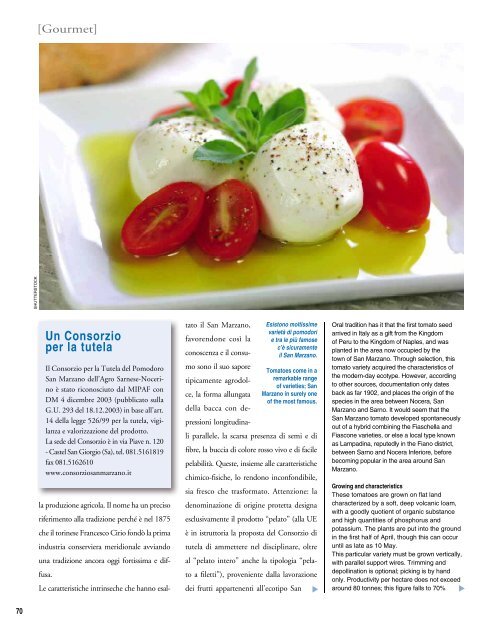COPIA OMAGGIO ⢠COMPLIMENTARY COPY EDIZIONI PRC
COPIA OMAGGIO ⢠COMPLIMENTARY COPY EDIZIONI PRC
COPIA OMAGGIO ⢠COMPLIMENTARY COPY EDIZIONI PRC
You also want an ePaper? Increase the reach of your titles
YUMPU automatically turns print PDFs into web optimized ePapers that Google loves.
[Gourmet]<br />
SHUTTERSTOCK<br />
Un Consorzio<br />
per la tutela<br />
Il Consorzio per la Tutela del Pomodoro<br />
San Marzano dell’Agro Sarnese-Nocerino<br />
è stato riconosciuto dal MIPAF con<br />
DM 4 dicembre 2003 (pubblicato sulla<br />
G.U. 293 del 18.12.2003) in base all’art.<br />
14 della legge 526/99 per la tutela, vigilanza<br />
e valorizzazione del prodotto.<br />
La sede del Consorzio è in via Piave n. 120<br />
- Castel San Giorgio (Sa), tel. 081.5161819<br />
fax 081.5162610<br />
www.consorziosanmarzano.it<br />
la produzione agricola. Il nome ha un preciso<br />
riferimento alla tradizione perché è nel 1875<br />
che il torinese Francesco Cirio fondò la prima<br />
industria conserviera meridionale avviando<br />
una tradizione ancora oggi fortissima e diffusa.<br />
Le caratteristiche intrinseche che hanno esaltato<br />
il San Marzano, Esistono moltissime<br />
varietà di pomodori<br />
favorendone così la e tra le più famose<br />
c’è sicuramente<br />
conoscenza e il consumo<br />
sono il suo sapore<br />
il San Marzano.<br />
Tomatoes come in a<br />
tipicamente agrodolce,<br />
la forma allungata Marzano in surely one<br />
remarkable range<br />
of varieties; San<br />
of the most famous.<br />
della bacca con depressioni<br />
longitudinali<br />
parallele, la scarsa presenza di semi e di<br />
fibre, la buccia di colore rosso vivo e di facile<br />
pelabilità. Queste, insieme alle caratteristiche<br />
chimico-fisiche, lo rendono inconfondibile,<br />
sia fresco che trasformato. Attenzione: la<br />
denominazione di origine protetta designa<br />
esclusivamente il prodotto “pelato” (alla UE<br />
è in istruttoria la proposta del Consorzio di<br />
tutela di ammettere nel disciplinare, oltre<br />
al “pelato intero” anche la tipologia “pelato<br />
a filetti”), proveniente dalla lavorazione<br />
dei frutti appartenenti all’ecotipo San<br />
<br />
Oral tradition has it that the first tomato seed<br />
arrived in Italy as a gift from the Kingdom<br />
of Peru to the Kingdom of Naples, and was<br />
planted in the area now occupied by the<br />
town of San Marzano. Through selection, this<br />
tomato variety acquired the characteristics of<br />
the modern-day ecotype. However, according<br />
to other sources, documentation only dates<br />
back as far 1902, and places the origin of the<br />
species in the area between Nocera, San<br />
Marzano and Sarno. It would seem that the<br />
San Marzano tomato developed spontaneously<br />
out of a hybrid combining the Fiaschella and<br />
Fiascone varieties, or else a local type known<br />
as Lampadina, reputedly in the Fiano district,<br />
between Sarno and Nocera Inferiore, before<br />
becoming popular in the area around San<br />
Marzano.<br />
Growing and characteristics<br />
These tomatoes are grown on flat land<br />
characterized by a soft, deep volcanic loam,<br />
with a goodly quotient of organic substance<br />
and high quantities of phosphorus and<br />
potassium. The plants are put into the ground<br />
in the first half of April, though this can occur<br />
until as late as 10 May.<br />
This particular variety must be grown vertically,<br />
with parallel support wires. Trimming and<br />
depollination is optional; picking is by hand<br />
only. Productivity per hectare does not exceed<br />
around 80 tonnes; this figure falls to 70%<br />
<br />
70



